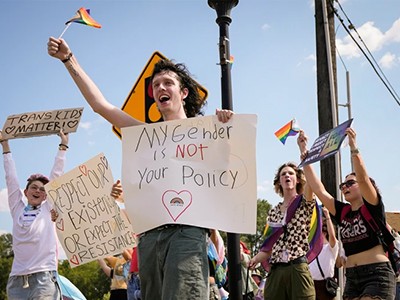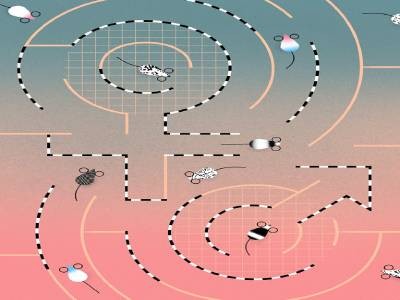[ad_1]
Over the past decade, intense and polarizing debates about transgender rights and women’s bodies have escalated worldwide — from politicians being grilled on the definition of a woman to scientific journals being critiqued for the language they use in discussions of women’s health. Meanwhile, studies have accumulated showing that the impacts of sex and gender on human health and behaviour are both far-reaching and complex. This is in part the result of major funding agencies, such as the Canadian Institutes of Health Research and the US National Institutes of Health, as well as various scientific journals1, developing guidelines and mandates to encourage scientists to consider sex and gender in their research (see Nature 605, 396 (2022); Nature Commun. 13, 2845; 2022).
Given the heightened sociopolitical tensions and a widespread perception that considering sex and gender (terms we define below) will ramp up the complexity and costs of research, many scientists might feel it is prudent to avoid examining them in their work. However, studies that engage critically with sex and gender are urgently needed, both to increase understanding of humans across diverse contexts, and to provide insights for societal discussions — whether on health and disease, education or other topics.
Why it’s essential to study sex and gender, even as tensions rise
Clinicians and regulatory agencies still lack knowledge about how factors related to sex and gender, and their interactions, affect the likelihood of being prescribed a drug, of experiencing severe side effects or of receiving an incorrect dose2. Similarly, in relation to disaster relief, organizations providing aid to those in need could increase the effectiveness of their efforts if they better understood how sex and gender affect people’s ability to access health services, food or water — in the context of sexualized or gender-based violence, say, or because of gendered stereotypes and roles3. To make future products more useful to everyone, many engineering and design fields, from artificial intelligence to robotics, need sex- and gender-informed research. The design of commonly used products, such as seat belts and airbags, needs to take into account factors related to sex and gender to address women’s increased risk of injury and fatality in vehicle crashes4. We urge scientists to engage with the concepts and issues surrounding sex and gender, and to consider the relevance of them to their own field. We also entreat them to embrace complexity, and develop deeper, more-nuanced approaches to interrogating sex and gender than are most commonly used today. This means, among other things, engaging deeply with the mechanisms and factors that underlie apparent differences between groups5.
Causes of confusion
For most research that considers sex and/or gender, limited information is collected for either attribute. For studies involving humans, participants are typically asked to identify their sex and/or gender category; for those involving non-human animals, individuals are usually assigned to a sex category depending on the appearance of their genital anatomy.
Meanwhile, when it comes to promoting understanding of the concepts of sex and gender and the distinctions between them, a starting point frequently offered — including by major research funders — is that sex is biological and gender is social. In other words, sex is meant to refer to various anatomical and other biological features, whereas gender is associated with social and cultural attributes, opportunities and roles.
Splitting data by sex or gender category can be a useful starting point to help identify sex- and gender-related differences and disparities. Similarly, the ‘sex is biological and gender is social’ framing can offer a valuable initial toehold, because it serves as a reminder that not every difference observed between sex or gender groups is rooted in biology: social and environmental factors are often important, too.
Male–female comparisons are powerful in biomedical research — don’t abandon them
Ultimately, however, both the approaches commonly used to categorize individuals and the way in which many researchers think about sex and gender do not necessarily lead to studies that can adequately address the complexities and diversity of humans. They can even be misleading.
For a start, sex is not a fixed thing. Neither is gender.
For us, the term sex is best understood as both a categorization scheme (in which individuals are typically classed as male, female or intersex) and a complex constellation of traits and factors across several levels of biological organization that show considerable variability between and within individuals. Sex-related factors and traits include anatomical features, hormones, levels of gene expression and physiological, reproductive, metabolic or neurological processes — but no single trait comprehensively defines an individual’s sex. In all animals, including humans, developmental processes that occur during sexual differentiation (during fetal development and after birth) are not determined by single genes. Instead, sex phenotypes emerge from the complex interplay of numerous molecular pathways that can be influenced by environmental experiences through epigenetic, endocrine, neurological and other mechanisms across people’s lifespan6.
Similarly, the term gender encompasses much more than people’s sense of self as a gendered individual, or their ‘gender identity’. Gender can be understood as a categorization scheme, in which a person can identify as a man or woman (whether cisgender or trans), as non-binary or with one or more other evolving terms. Gender also encompasses roles, norms, relations and opportunities that vary between cultures and over time, and which affect people’s income, autonomy, domestic and public roles, and their access to power and resources.
Furthermore, sex and gender are not neatly separable.
Nature journals raise the bar on sex and gender reporting in research
Various studies have shown that environmental and social factors can affect people’s biology in numerous ways. Gendered dressing patterns affect people’s exposure to sunlight7, for instance, affecting their levels of vitamin D, which can in turn influence bone density8,9. In other words, although bone density is affected by levels of oestrogen or testosterone, it should not be understood as solely a sex-related trait, but as something that is shaped by social and environmental factors rooted in gender, too. Similarly, patterns of gendered socialization related to dress, types of play (for example, indoor or outdoor) and vigilance about cleanliness might result in boys and girls having distinct patterns of exposure to microorganisms — which could, in turn, have implications for the maturation of their immune system and susceptibility to developing conditions such as an allergy or autoimmune disorder10. Some scholars focusing on issues around sex and gender use the hybrid terms gender/sex or sex/gender in recognition of such entanglement11,12.
To add to the difficulties, many scientific organizations, journals and researchers fail to clarify what exactly they mean by sex and gender, or they conflate the terms or use them interchangeably. Moreover, patterns of use can differ according to people’s language, discipline or country. For example, the term gender medicine has been used to describe at least three distinct things: a branch of medicine focused on disease-related differences between men and women13; the study of how sex and gender influence an individual’s health14,15; and the provision of care for children with differences in sexual development16. To help address this confusion, we have mapped the relationships between various areas of science concerned with sex and gender, and policies linked to equity, diversity and inclusion17.
Embracing complexity
In our view, continued dialogue between scholars and journal editors will help to clarify and refine terminologies. However, putting aside the problems with how the terms are used and understood, when sex and gender are considered in research at all, the standard approach is to compare female and male individuals. Such comparisons can be useful for flagging characteristics that warrant further investigation. However, in making such comparisons, researchers often overlook the fact that there is substantial heterogeneity in sex/gender categories and substantial overlap between them for many traits. Ultimately, relying too heavily on a binary comparison approach risks describing the realities incorrectly for everyone, not just for women or non-binary people. It also contributes to the marginalization of those with variations in sexual development and people with diverse gender identities.
Take, for example, research on blood donation. In 2017, researchers in Canada published findings that among frequent blood donors, women had low levels of ferritin (a marker of iron levels) more often than did men18. The study prompted Canadian Blood Services — the organization that manages most of the country’s blood supply — to alter its policy on donation intervals: for all female donors, it has extended the time between donations from 8 to 12 weeks. (Since January 2023, Canadian Blood Services has also been intermittently testing ferritin levels in donors’ blood, but only in women.)

Gendered roles and behaviours affect people’s health and well-being.Credit: Diptendu Dutta/AFP/Getty
By focusing the policy on the sex category of the donor, the organization effectively treats all women as being at the same risk of low iron levels, which is higher than that of men, without attending to the specific factors that are most likely to be mechanistically related to that risk: body size, amount of menstrual blood loss and dietary iron intake. The change to donation interval for women — based on a binary analysis — also glosses over the heterogeneous and overlapping nature of the data, including the fact that the frequent donors also included women who did not have low iron levels, and men who did. A more nuanced interpretation of the findings, along with further research that probed the specific sex- and gender-related factors that increase people’s risk of developing low iron levels, could allow policies to be refined in ways that are better oriented to the mechanistic factors that matter most.
A spokesperson for Canadian Blood Services said that it recognizes that blood donors are a heterogeneous population and that it uses standardized, simple criteria to divide donors into accepted and deferred groups.
Accounting for sex and gender makes for better science
In practice, each investigator is best placed to work out which sex- and gender-related factors will be most important to assess on the basis of their study system, goals, tools, methods and resources19, and — crucially — best placed to justify these decisions. Not every possible variable relating to sex and gender needs to be interrogated in all contexts, and there is no one-size-fits-all approach.
Someone studying a new T-cell therapy for colon cancer, for example, might propose that gonadal hormones could modify the efficacy of the treatment, because T cells possess receptors for both oestrogens and androgens. If that researcher was conducting a study in people with colon cancer, they could evaluate whether correlations exist between the efficacy of the drug and serum concentrations of the relevant hormones (which can be affected by biological, social and environmental factors). If they were working with a mouse model of colon cancer, they might use antagonists or agonists of the relevant hormone receptors or give the animals hormone supplements. A different approach would be needed if the researcher was interested in whether the sex of the T-cell donor changes the efficacy of the treatment depending on the sex of the recipient.
These kinds of analysis could have resource implications: in some cases, different reagents, extra measurements or more animals or participants would be required. In our view, considerable resources should be invested in addressing long-standing gender inequities. Furthermore, researchers do not necessarily need to consider sex and gender in every experiment or study. More important is that they build sufficient skills and understanding to be able to consider the potential impacts of sex and gender and justify their research designs accordingly.
Implicit bias
In addition to considering sex and gender in their work and taking more-nuanced approaches to studying both, it is crucial that researchers explore how the influences of sex and/or gender shape their own research.
The fraught quest to account for sex in biology research
Many phenomena in diverse fields, including medicine, archaeology and history, show that science has never been insulated from social and cultural biases, or from stereotypes and mythologies about sex and gender. Funders and regulators are still trying to remedy the lack of inclusion or under-representation of women in clinical trials of drugs or devices. Such biases lead to common mislabelling such as ‘the male hormone testosterone’ or ‘the female X chromosome’ even though testosterone and X chromosomes are important for normal physiological function in all human bodies. Likewise, many studies assess the effects of androgens in only male participants, for instance, or analyse only women’s child-care responsibilities.
Truly understanding the impacts of sex and gender on human life will require a mix of transdisciplinary, quantitative, qualitative and intersectional analyses — which strive to assess how people’s experiences are shaped by interacting social processes, such as racism, sexism, homophobia, transphobia, ableism and colonialism.
Given the enormous untapped opportunities for developing insights concerning sex and gender across many contexts, it is essential that more scientists lean in with courage and creativity to interrogate the fascinating complexity of sex- and gender-related impacts — to the benefit of all.
[ad_2]
Source Article Link






